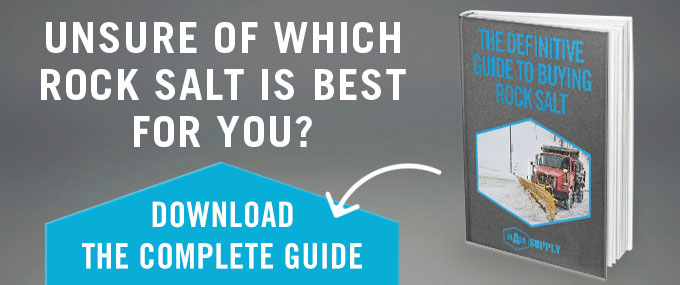 Melting existing ice, and preventing water from freezing on your property is one of the most important things that you can do to maintain your home’s property during the winter months.
Melting existing ice, and preventing water from freezing on your property is one of the most important things that you can do to maintain your home’s property during the winter months.
With so many different types of ice melting products on the market though, you may find yourself wondering which to purchase. What’s the difference between traditional rock salt, and other de-icers like ice melt and pellets? By taking a closer look at the characteristics of each, you can make the best decision for your needs.
Rock Salt
Although commonly referred to as rock salt, the technical name for this de-icer is Halite, and it is the mineral form of sodium chloride. Most people are familiar with the concept of utilizing rock salt as a means of melting icy patches on their driveways, front steps or their walkways, but don’t really understand how it works. When the salt begins to penetrate the ice, it forms brine (a solution of salt and water). Brine has a lower freezing point than pure water, which then causes the ice to melt.
Rock salt is capable of lowering the freezing point down to 25 degrees Fahrenheit. Because of this, the mineral is most effective in areas that do not typically deal with extremely low temperatures. In regions where the temperature may fluctuate between falling below 25 degrees and rising above it, rock salt could actually cause damage to surfaces. This is because the frequent freeze and thaw cycles can cause concrete to crack, or to develop weak spots.
Ice Melt
Of the ice melt products available, the most prevalent salt varieties include calcium chloride, magnesium chloride, sodium chloride and potassium chloride.
Calcium chloride is thought to be the most effective of all ice melts, as it is able to melt ice faster, and in much colder temperatures. It is actually capable of bringing the freezing point of water down to -25 degrees Fahrenheit. The most unique aspect of this particular type of ice melt is that it not only forms a brine, like rock salt, but it also generates heat, speeding up the melting process.
With the exception of potassium chloride, all of the most common ice melts are able to work in colder temperatures than rock salt. Homeowners should be advised, though, that some ice melt products can be harmful to pets. Usually ice melt is in the form of fairly large granules or flakes, but may sometimes be found in liquid form.
Ice Melt Pellets
Ice melting pellets are quite similar to other ice melt products, with the exception of the form that they take. As the name suggests, pellets are round and circular, and are typically the size of a pea. This has both its advantages and disadvantages. The pellet shape enables the product to really bore into, and beneath, the surface of ice which helps in quickly developing a strong brine. This also makes it easier for homeowners to further clear snow and ice from their properties, as the bond of ice to the surface being cleared is weakened. Unfortunately, the pellets may also tend to roll on sloped driveways and surfaces.
All de-icers come with their own unique set of pros and cons. By considering these, as well as your needs, you’ll find the right fit. If you’re still unsure about the type of de-icer that is best for you, speak with a supplier for more information.

